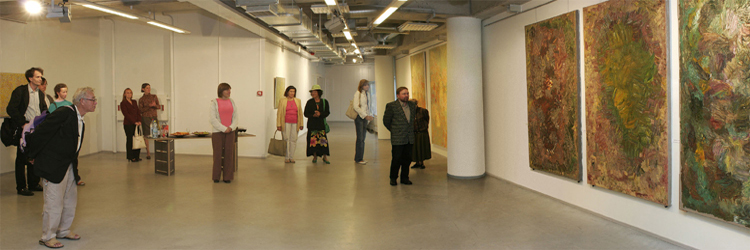Visions from the Dark Side of Uranus
An artist Ove Büttner presents his new cycle of paintings, "Uranus", in the St. Olaf's Hall of the House of the Brotherhood of Blackheads. Up to the 15th of May.
An informal opening ceremony. Matti Milius swept the hall as a cheerful breeze and shouted in his peculiar way: "Ove, now you cannot get away any more! I specially came to Tallinn for the opening of your show - you have to present me a picture!" Looking around for a moment, he expressed his modest wish to acquire the smallest painting at the exhibition into his collection. How could the artist be against it.
A gallerist, Mari Sobolev, explained that they usually do not organise exhibitions in St. Olaf's Hall. But when an idea emerged to organise the exhibition of Ove Büttner's paintings in the house and the artist came to look at the premises, he announced at once after entering St. Olaf's Hall that he would place his works in the wall niches and the end of the story.
I recall of Ove Büttner's exhibition "Time Tunnel" in Tallinn Town Prison Museum in the beginning of the previous year. The theme of everlasting circle of matter is elaborated in the new pictures, dated from this year, too. These are structures, enlargements of substance. They might be, for instance, the structures of grey stone: as it is generally known, grey is the mixture of all colours and without exaggeration one can say that there are various splotches, blotches and dots of colour on Büttner's paintings...
Ove Büttner offers his personal vision of the dark side of Uranus. The side that has not been photographed for the inhabitants of Earth. The artist raises an issue - who profits from no photos been taken of Uranus? - and tries to compensate it in his own way. "Perhaps this is disinformation?" the artist slyly smiles.
In principle, Ove Büttner continues to paint in the same style, by which he has been enchanting us in the recent years. At the first glance, the colour games charm the viewer. The rest follows: the fantasies, the pellmell of thoughts that makes to forget oneself, sparks, interpretations - everything the art provokes in its public. Iridescent colours are, however, not vanished, though the colour gammut of some canvases is more melancholic than of the previous ones, sporadically even turned depressive brown. This is the hidden and discreet, but completely perceptible reflection of personal losses in the art. Laughter through tears, through the suffering. The paintings are quite impressive. Even so impressive that will obviously start competing with music, performed at the concerts in the St. Olaf's Hall.
